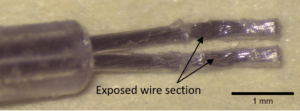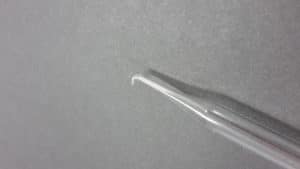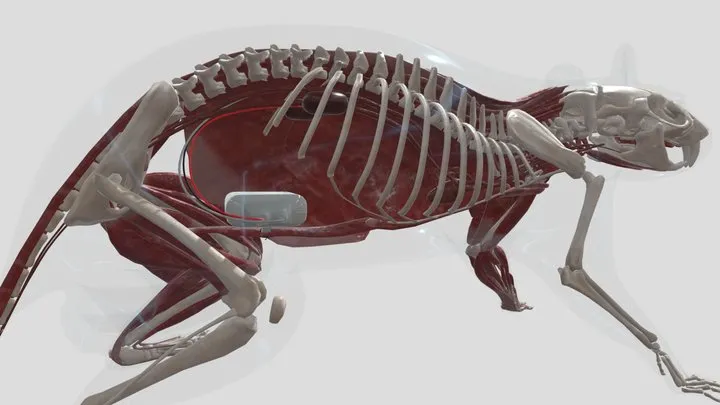The Kaha Sciences TRM56SP telemeter can be used to record arterial pressure and sympathetic nerve activity (SNA) in rats. This series of videos shows one surgical method used by researchers to record renal sympathetic nerve activity. The techniques described can be modified to record SNA to other organs including from the lumbar and splanchnic nerves.
Important points for good SNA recordings are:
- Nerves are delicate living tissue and are easily damaged. Make sure that the nerve is not stretched, crushed or allowed to dry out.
- Use a customized glass hook with a rounded tip to handle the nerve to minimize damage. Never pick up the nerve with forceps.
- Ensure there is good contact between the nerve and both electrode wires but make sure the electrode wires aren’t touching each other.
- Make sure the nerve and exposed electrode wires are fully covered with silicone gel (e.g. Kwik-Sil).
Some useful references describing techniques for recording and quantification of SNA are:
- Stocker & Muntzel, Recording sympathetic nerve activity chronically in rats: surgery techniques, assessment of nerve activity, and quantification. Am J Physiol Heart Circ Physiol. 2013; 305(10):H1407-16. https://www.ncbi.nlm.nih.gov/pubmed/24014674
- Hart et al. Recording sympathetic nerve activity in conscious humans and other mammals: guidelines and the road to standardization. Am J Physiol Heart Circ Physiol. 2017; 312(5):H1031-H1051. https://www.ncbi.nlm.nih.gov/pubmed/28364017
- Guild et al. Quantifying sympathetic nerve activity: problems, pitfalls and the need for standardization. Exp Physiol. 2010; 95(1):41-50. https://www.ncbi.nlm.nih.gov/pubmed/19700515
Pre-Implantation preparation
The recording electrodes of the TRM56SP are made from multi-stranded stainless steel wires. To prepare the electrodes for surgery, remove the insulation from the part of the wires that will be in contact with the nerve and the wires should be shaped into hooks. Do not strip the ends of the wires completely or the individual strands will splay apart and make working with the electrode very difficult. Electrode preparation can be done at the time of surgery or before sterilization prior to surgery (e.g. on reuse) depending on the user's preference.

The first stage of the surgery is to implant the blood pressure catheter and body of the telemeter following the procedures outlined in the Arterial Blood Pressure section.
Tunneling of electrodes
The easiest approach to the renal nerves is via a retroperitoneal incision on the side of the rat. The blood pressure catheter should be implanted using the standard abdominal mid-line incision with the rat lying on its back. The SNA recording electrodes and grounding electrode/earth wire will need to be tunneled under the skin to allow access via the side incision. To maintain sterility, we recommend that the electrodes are tunneled under the skin and the abdominal incision is closed before the animal is rolled to its side and the second incision made.
Isolating the renal sympathetic nerve and attaching the electrodes
The renal sympathetic nerve can be found running alongside the renal artery and vein. To access this area, customized Alm retractors (Fine Science Tools; 17009-07) are used to retract the kidney and retroperitoneal fat. These retractors have been customized by bending the two middle teeth of one side apart and covering the teeth with blobs of silicone. The gap allows the kidney to be retracted without compressing the renal artery and vein and the silicone protects the delicate kidney tissue.
Connective tissue is a poor conductor and excess tissue left around the nerve will prevent a good signal from being recorded. It is a balancing act between removing as much connective tissue as possible but without damaging the nerve itself.

A glass hook is used to carefully handle the nerve with minimal damage. This hook is made by heating a glass Pasteur pipette in the flame of a Bunsen burner. Once the glass is softened, the end of the pipette can be grasped with plyers or hemostats and twisted and pulled to create a hook. Make sure to melt the tip to ensure it is rounded. Before each use, always check the hook has a rounded end as they are easily broken and a sharp end will damage the nerve.

A good SNA signal requires that the nerve/recording electrode area be properly insulated from the surrounding tissue. We recommend the use of Kwik-Sil silicone elastomer. The method shown in the video also recommends the use of a piece of parafilm under the attachment site to help get the silicone underneath the nerve/electrode.
Securing the electrodes
It is important that the electrodes are properly secured to stop them tugging on the nerve when the animal moves. Even with the electrodes secured, the animals should be handled carefully e.g. scooped up with two hands, supporting the abdomen, rather than picking them up by the tail.
Videos contain content hosted by Millar prior to the formation of Kaha Sciences. Kaha Sciences is an ADInstruments brand. Any contact details provided in videos are now out of date - For all product information or support, please contact us.
